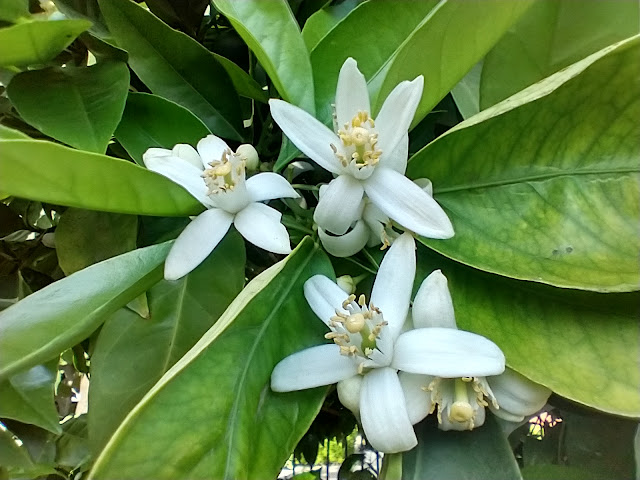
Rain coming soon -- but how much?

|
|
Orange trees are blooming, including this one in Midtown Sacramento. The blossoms are a reminder to give the trees a low dose of balanced fertilizer. (Photo:
Debbie Arrington)
|
Sacramento can (finally) expect more rain Monday, maybe even Sunday evening. But how much?
According to the National Weather Service, estimates are just that – estimates. This fast-moving storm system could drop as much as an inch of rain on Sacramento – or just 0.10.
Most likely, it will be somewhere in between those amounts. As of late Friday night, the weather service pegs Sacramento's total at 0.62 inches with “definite rain showers and thunderstorms” forecast throughout Monday.
Otherwise, our final days of March will stay mostly on the warm side with afternoons in the mid 70s while overnight lows will keep dipping into the 40s.
Expect more of the same for at least a little while. April in Sacramento averages highs of 71 degrees and lows of 46.
* Smell orange blossoms? Feed citrus trees with a low dose of balanced fertilizer (such as 10-10-10) during bloom to help set fruit. Keep an eye out for ants.
* Early spring is the last chance to plant citrus trees such as dwarf orange, lemon and kumquat. These trees also look good in landscaping and provide fresh fruit in winter.
* Apply slow-release fertilizer to the lawn.
* Watch out for powdery mildew and other fungal diseases.
* Knock aphids off plants with a strong blast of water.
* Thoroughly clean debris from the bottom of outdoor ponds or fountains.
* Spring brings a flush of rapid growth, and that means your garden is really hungry. Feed shrubs and trees with a slow-release fertilizer. Or mulch with a 1-inch layer of compost.
* Azaleas and camellias looking a little yellow? If leaves are turning yellow between the veins, give them a boost with chelated iron.
* Trim dead flowers but not leaves from spring-flowering bulbs such as daffodils and tulips. Those leaves gather energy to create next year's flowers. Also, give the bulbs a fertilizer boost after bloom.
* Transplant lettuce and cabbage seedlings.
* Gradually expose tomato and pepper seedlings to outdoor conditions, starting with a few hours in morning sun. As soil warms, these "hardened off" transplants can go in the ground.
* From seed, plant beets, carrots, chard, chives, fennel, mustard, radishes, squash and turnips. Plant seed potatoes.
* In the flower garden, plant seeds for asters, cosmos, celosia, marigolds, salvia and sunflowers.
* Transplant petunias, geraniums and other summer bloomers.
* Plant perennials and dahlia tubers for summer bloom.
Comments
0 comments have been posted.Sacramento Digs Gardening to your inbox.
Sites We Like
Garden Checklist for week of Nov. 3
November still offers good weather for fall planting:
* If you haven't already, it's time to clean up the remains of summer. Pull faded annuals and vegetables. Prune dead or broken branches from trees.
* Now is the best time to plant most trees and shrubs. This gives them plenty of time for root development before spring growth. They also benefit from fall and winter rains.
* Set out cool-weather annuals such as pansies and snapdragons.
* Lettuce, cabbage and broccoli also can be planted now.
* Plant garlic and onions.
* Keep planting bulbs to spread out your spring bloom. Some possible suggestions: daffodils, crocuses, hyacinths, tulips, anemones and scillas.
* This is also a good time to seed wildflowers and plant such spring bloomers as sweet pea, sweet alyssum and bachelor buttons.
* Rake and compost leaves, but dispose of any diseased plant material. For example, if peach and nectarine trees showed signs of leaf curl this year, clean up under trees and dispose of those leaves instead of composting.
* Save dry stalks and seedpods from poppies and coneflowers for fall bouquets and holiday decorating.
* For holiday blooms indoors, plant paperwhite narcissus bulbs now. Fill a shallow bowl or dish with 2 inches of rocks or pebbles. Place bulbs in the dish with the root end nestled in the rocks. Add water until it just touches the bottom of the bulbs. Place the dish in a sunny window. Add water as needed.
* Give your azaleas, gardenias and camellias a boost with chelated iron.
* For larger blooms, pinch off some camellia buds.
* Prune non-flowering trees and shrubs while dormant.
* To help prevent leaf curl, apply a copper fungicide spray to peach and nectarine trees after they lose their leaves this month. Leaf curl, which shows up in the spring, is caused by a fungus that winters as spores on the limbs and around the tree in fallen leaves. Sprays are most effective now.